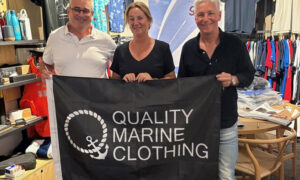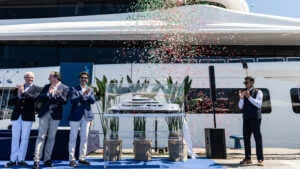‘Bayesian is being raised in the name of evidence, not salvage’
 Bayesian photographed in Milazzo Harbor; Sicily. before the accident. Image courtesy of Sfische via Wikimedia.
Bayesian photographed in Milazzo Harbor; Sicily. before the accident. Image courtesy of Sfische via Wikimedia.
The recovery of the superyacht Bayesian has begun off the coast of Porticello in Italy, following the publication of an interim report by the UK’s Marine Accident Investigation Branch (MAIB) on 15 May.
The report details the final moments of Bayesian, owned by British tech tycoon Mike Lynch, which sank off Sicily in August 2024, resulting in the death of Lynch and six others. MAIB’s report concluded that wind speeds of 63.4 knots (117km/h) on the yacht’s beam were sufficient to render Bayesian listing, and that the yacht could not recover once it had heeled beyond 70-degree list.
The Italian Sea Group (TISG), owner of the Perini Navi shipyard that built Bayesian, has declined to comment on MAIB’s report to global media.
The tragedy was compounded on 9 May when a Dutch diver working on preliminary operations to raise Bayesian died during underwater salvage work.
In this special report for Marine Industry News, maritime lawyers Enrico Vergani and Marco Mastropasqua from BonelliErede’s shipping, transport and logistics focus team analyse the legal, commercial and environmental complexities surrounding the judicially mandated recovery of Bayesian.
The raising of Bayesian: legal, commercial and environmental implications
Unlike standard wreck recoveries, the raising of Bayesian is a judicially mandated recovery, overseen by the Italian Coast Guard in its judicial police function. The primary goal is not financial salvage or disposal but the preservation of forensic evidence for an ongoing criminal investigation before the Criminal Court of Termini Imerese.
Legal duty to preserve evidence
Under Italian law, when an investigation is underway, the salvage team must prioritise that evidence remains intact for the forensic investigation. Bayesian’s recovery is dictated by legal imperatives, meaning that every action must strictly follow protocols that prevent contamination or destruction of potential evidence. This duty overrides standard salvage priorities and requires extreme caution when raising the vessel.
Balancing this legal duty with practical challenges – such as ensuring the yacht can be raised without compromising its structural integrity – is a complex engineering problem. While salvage teams typically prioritise efficiency and cost-effectiveness, the Bayesian operation must prioritise forensic integrity, even if this complicates logistics.
Key differences between the Bayesian and other maritime recoveries
Although the Bayesian recovery might draw comparisons to high-profile operations like the Costa Concordia, there are substantial differences between their objectives and methodologies.
- Costa Concordia’s wreck removal was driven by environmental and commercial priorities – to eliminate an ecological hazard.
- Bayesian, in contrast, is being raised solely to ensure that investigators can fully examine structural and technical aspects related to its sinking.
Unlike conventional wreck removal, wherein the vessel is dismantled, the emphasis here is on keeping the structure intact for the legal proceedings.

Personal objects: legal and emotional considerations
An important aspect of maritime recovery operations is the fate of personal belongings found onboard. Italian law allows survivors and families of the victims to reclaim items if they have no evidentiary value in the investigation. If objects are considered critical to forensic analysis, they may be retained until judicial proceedings conclude.
Among the recovered personal effects, particular attention has been given to electronic devices once belonging to Mike Lynch. Sources suggest that hard drives, computers and external storage units were found onboard, potentially containing sensitive data linked to Lynch’s work with intelligence agencies. These items, reportedly highly encrypted, are now under forensic examination by authorities to determine their significance in the ongoing investigation.
Items not essential to the case, such as luggage or jewellery, may eventually be returned. Precedents from similar maritime investigations suggest that belongings often undergo classification by forensic experts before release. However, given the potential security implications surrounding the recovered data storage devices, their handling remains subject to heightened scrutiny by both Italian and International intelligence entities.
Legal consequences for crew members
If the investigation uncovers negligence or incompetence by the surviving crew, they could face civil or criminal proceedings. Italian maritime law imposes strict liability, and depending on the findings, charges could range from manslaughter to gross negligence or maritime misconduct.
The Costa Concordia case highlights how individuals – particularly captains and officers – can be held personally accountable for decisions that contributed to a vessel’s sinking. If evidence from the Bayesian’s recovery points to failures in command, the affected parties may bring action for damages, and prosecutors could bring criminal charges against those responsible.
Commercial and environmental implications
Although the Bayesian’s recovery is ordered by judicial authorities, commercial firms still play a crucial role. Specialised marine engineering companies have been contracted to raise and stabilise the yacht, but their work must conform to the strict forensic preservation standards set by judicial authorities.
Additionally, environmental protection remains a critical legal obligation. Italian law and international treaties, including MARPOL regulations, require salvage teams to mitigate risks such as fuel leaks and debris contamination. Authorities overseeing the operation will demand compliance with environmental protection measures while ensuring investigative integrity remains uncompromised.
In conclusion, Bayesian’s recovery illustrates a significant shift in maritime operations, where forensic investigations take precedence over traditional salvage motivations. Unlike financial salvage or environmental remediation, this case is driven by the need to preserve evidence, thus shaping the course of judicial proceedings related to the vessel’s loss.
This operation could also set legal precedents for future maritime incident recoveries, reinforcing the need for advanced forensic expertise and stricter judicial oversight in salvage operations. As legal frameworks continue to evolve, the intersection between marine engineering and judicial investigation is likely to redefine industry standards.
About the authors

Enrico Vergani is a partner in BonelliErede’s shipping, transport and logistics focus team. He specialises in maritime law, shipbuilding/ship conversion matters, litigation and international arbitration and project financing for shipping, transport and infrastructure. He frequently writes about issues affecting the world of shipping, and is recognised as an expert on shipping law in Italy by both Chambers & Partners and the Legal 500 EMEA legal directories.

Marco Mastropasqua is senior counsel in BonelliErede’s shipping, transport and logistics focus team. His practice covers a wide range of maritime matters, including international shipping financing, insurance, maritime and shipping law, and offshore law. He is recognised by the Legal 500 EMEA as a Leading Associate in Italy on shipping law.












